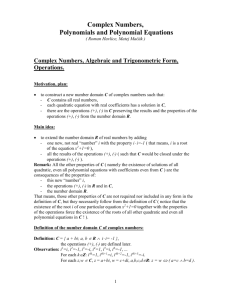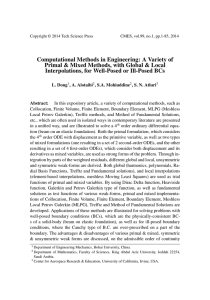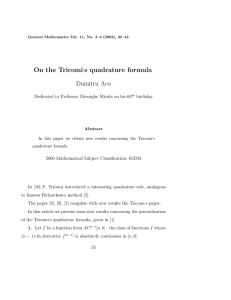POLYNOMIAL SPLINE COLLOCATION METHODS FOR SECOND-ORDER VOLTERRA INTEGRODIFFERENTIAL EQUATIONS
advertisement
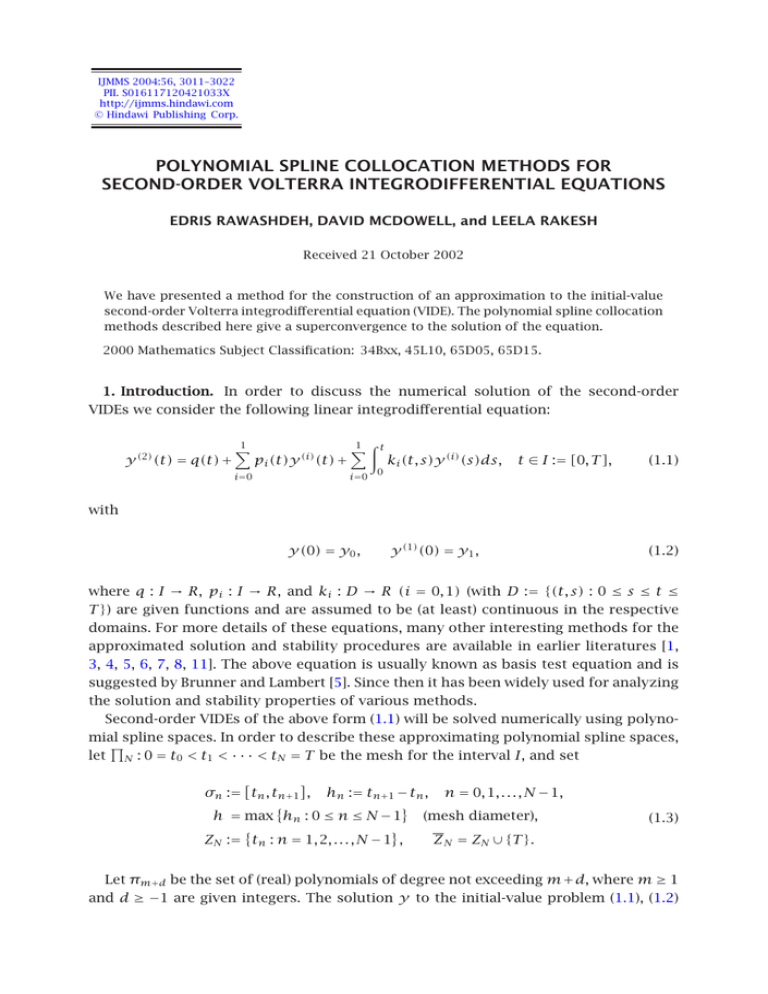
IJMMS 2004:56, 3011–3022
PII. S016117120421033X
http://ijmms.hindawi.com
© Hindawi Publishing Corp.
POLYNOMIAL SPLINE COLLOCATION METHODS FOR
SECOND-ORDER VOLTERRA INTEGRODIFFERENTIAL EQUATIONS
EDRIS RAWASHDEH, DAVID MCDOWELL, and LEELA RAKESH
Received 21 October 2002
We have presented a method for the construction of an approximation to the initial-value
second-order Volterra integrodifferential equation (VIDE). The polynomial spline collocation
methods described here give a superconvergence to the solution of the equation.
2000 Mathematics Subject Classification: 34Bxx, 45L10, 65D05, 65D15.
1. Introduction. In order to discuss the numerical solution of the second-order
VIDEs we consider the following linear integrodifferential equation:
y (2) (t) = q(t) +
1
i=0
pi (t)y (i) (t) +
1 t
i=0
0
ki (t, s)y (i) (s)ds,
t ∈ I := [0, T ],
(1.1)
with
y(0) = y0 ,
y (1) (0) = y1 ,
(1.2)
where q : I → R, pi : I → R, and ki : D → R (i = 0, 1) (with D := {(t, s) : 0 ≤ s ≤ t ≤
T }) are given functions and are assumed to be (at least) continuous in the respective
domains. For more details of these equations, many other interesting methods for the
approximated solution and stability procedures are available in earlier literatures [1,
3, 4, 5, 6, 7, 8, 11]. The above equation is usually known as basis test equation and is
suggested by Brunner and Lambert [5]. Since then it has been widely used for analyzing
the solution and stability properties of various methods.
Second-order VIDEs of the above form (1.1) will be solved numerically using polynomial spline spaces. In order to describe these approximating polynomial spline spaces,
let N : 0 = t0 < t1 < · · · < tN = T be the mesh for the interval I, and set
σn := tn , tn+1 , hn := tn+1 − tn , n = 0, 1, . . . , N − 1,
(mesh diameter),
h = max hn : 0 ≤ n ≤ N − 1
ZN := tn : n = 1, 2, . . . , N − 1 ,
Z N = ZN ∪ {T }.
(1.3)
Let πm+d be the set of (real) polynomials of degree not exceeding m+d, where m ≥ 1
and d ≥ −1 are given integers. The solution y to the initial-value problem (1.1), (1.2)
3012
EDRIS RAWASHDEH ET AL.
will be approximated by an element u in the polynomial spline space,
(d) Sm+d ZN := u := u(t)|t∈σn := un (t) ∈ πm+d , n = 0, 1, . . . , N − 1,
(j) (j) un−1 tn = un tn for j = 0, 1, . . . , d, tn ∈ ZN ,
(1.4)
that is, by a polynomial spline function of degree m + d which possesses the knots
ZN and is d times continuously differentiable on I. If d = −1, then the elements of
(−1)
Sm−1 (ZN ) may have jump discontinuities at the knots ZN . Initial value problems, such
as (1.1) and (1.2), have often been solved by collocation method in polynomial spines
(0)
(1)
spaces Sm (ZN ) and Sm (ZN ).
(d)
According to M. Miculá and G. Micula [10], an element u ∈ Sm+d (ZN ) has the following
form: for all n = 0, 1, . . . , N − 1 and t ∈ σn ,
d
m
(r ) r d+r
un−1 tn u(t) = un (t) =
an,r t − tn
,
t − tn +
r
!
r =0
r =1
(1.5)
where
ur−1 (0) :=
dr
u(t)
= y (r ) (0),
dt r
t=0
r = 0, 1, . . . , d.
(1.6)
(d)
From (1.5), we see that the element u ∈ Sm+d (ZN ) is well defined provided the coefficients {an,r }r =1,...,m are known. In order to determine these coefficients, we consider
a set of collocation parameters {cj }j=1,...,m , where 0 < c1 < · · · < cm ≤ 1, and define the
set of collocation points as
X(N) :=
N−1
Xn ,
with Xn := tn,j := tn + cj hn , j = 1, 2, . . . , m .
(1.7)
n=0
(d)
The approximate solution u ∈ Sm+d (ZN ) will be determined by imposing the condition that u satisfies the following initial-value problem on X(N):
u(2) (t) = q(t) +
1
pi (t)u(i) (t) +
i=0
1 t
i=0
0
ki (t, s)u(i) (s)ds,
∀t ∈ X(N),
(1.8)
with
u(0) = y0 ,
u(1) (0) = y1 ,
(1.9)
with a uniform the mesh sequence { N }, hn = h, for all n = 0, 1, . . . , N −1, but for small
h, (1.8) has a unique solution {an,j }j=1,...,m , for all n = 0, 1, . . . , N − 1.
POLYNOMIAL SPLINE COLLOCATION METHODS . . .
3013
Therefore, the modified collocation equation (1.8) can be rewritten as
u
n tn,j = q tn,j + p0 tn,j un tn,j + p1 tn,j un tn,j
n−1
j j hi φn,i ui
+ hn φn,n un +
(1.10)
i=0
j + ψn,n un +
n−1
j ψn,i ui ,
j = 1, . . . , m, n = 0, 1, . . . , N − 1,
i=0
where
cj
k0 tn,j , tn + vhn un tn + vhn dv,
0
j φn,i ui = 1
k0 tn,j , ti + vhi ui ti + vhi dv,
0
cj
k1 tn,j , tn + vhn un tn + vhn dv,
0
j ψn,i ui = 1
k1 tn,j , ti + vhi ui ti + vhi dv,
0
if i = n,
if i = 0, 1, . . . , n − 1,
(1.11)
if i = n,
if i = 0, 1, . . . , n − 1.
In most applications the integrals appearing in (1.11) cannot be evaluated analytically, so we seek suitable quadrature formulas as follows:
j φ̂ n,i ui
=
µ1
wj,l k0 tn,j , tn + dj,l hn un tn + dj,l hn ,
if i = n,
wl k0 tn,j , ti + dl hi ui ti + dl hi ,
if i = 0, 1, . . . , n − 1,
µ1
wj,l k1 tn,j , tn + dj,l hn un tn + dj,l hn ,
if i = n,
l=1
µ0
(1.12)
l=1
j ψ̂ n,i ui =
l=1
µ0
wl k1 tn,j , ti + dl hi ui ti + dl hi ,
(1.13)
if i = 0, 1, . . . , n − 1,
l=1
where µ0 and µ1 are two given positive integers, {dl } and {dj,l } are two sets of parameters satisfying the following conditions:
0 ≤ d1 < · · · < dµ0 ≤ 1,
0 ≤ dj,1 < · · · < dj,µ1 ≤ cj ,
(j = 1, . . . , m),
(1.14)
and wl , wj,l denote the quadrature weights.
The corresponding quadrature error terms are defined as
j j j En,i ui = φn,i ui − φ̂ n,i ui ,
j j j Én,i ui = ψn,i ui − ψ̂ n,i ui ,
j = 1, 2, . . . , m,
i = 0, 1, . . . , n
(n = 0, 1, . . . , N − 1).
(1.15)
3014
EDRIS RAWASHDEH ET AL.
By the above quadrature process (1.10) is a fully discretized collocation method
(d)
which defines an element û ∈ Sm+d (ZN ) (which, in general, will be different from the
approximate solution u determined by the exact collocation equation (1.10)). The full
discretized version of the collocation equation (1.10) is
û n tn,j = q tn,j + p0 tn,j ûn tn,j + p1 tn,j û n tn,j
n−1
j j hi φ̂ n,i û i
+ hn φ̂ n,n û n +
(1.16)
i=0
j + ψ̂ n,n û n +
n−1
j ψ̂ n,i û i ,
j = 1, . . . , m, n = 0, 1, . . . , N − 1.
i=0
(d)
Similarly, the approximate discretized solution û ∈ Sm+d (ZN ) has the following form:
d
m
(r ) r d+r
û n−1 tn û (t) = ûn (t) =
t − tn +
,
ân,r t − tn
r
!
r =0
r =1
(1.17)
with the assumption that
û−1 (r ) (0) := y (r ) (0),
r = 0, 1, . . . , d.
(1.18)
The collocation equations (1.10) and (1.16) represent recursive systems, for each n =
0, 1, . . . , N − 1, which yield the coefficients {an,r }r =1,...,m and {ân,r }r =1,...,m , respectively.
Once the coefficients are known, the values of u, û together with their derivatives are
determined on σn by (1.5) and (1.17), respectively.
On each of the N subintervals of I we have to solve an m × m system of linear
equations. On the first subinterval σ0 , d + 1 additional equations are furnished by the
d + 1 initial conditions (1.6) and (1.18).
2. Global convergence criteria. If the given functions q, pi , and ki (i = 0, 1) are of
class m + d on their domain of definition, then the VIDE (1.1) has a unique solution
y, which is of class m + d + 2. Let ϕn be the restriction of the function ϕ on I in the
subinterval σn , for n = 0, 1, . . . , N − 1, and the norm is defined by
ϕ∞ = sup ϕn (t) : t ∈ σn , n = 0, 1, . . . , N − 1 .
(2.1)
(d)
The following theorem describes the order of global convergence of u ∈ Sm+d (ZN ),
d ∈ {0, 1, 2}.
Theorem 2.1. Let q, pi , and ki be m + d times continuously differentiable in the
respective domains I and S. For d ∈ {0, 1, 2}, every choice of collocation parameters
{cj }j=1,m , with 0 < c1 < · · · < cm ≤ 1, and all quasiuniform mesh sequences { N } with
sufficiently small h > 0, the following hold:
3015
POLYNOMIAL SPLINE COLLOCATION METHODS . . .
(d)
(i) the exact collocation equation (1.10) defines a unique approximation u∈ Sm+d (ZN)
and the resulting error function e := y − u satisfies
(k) e ≤ Ck hm+d+1−k ,
∞
∀k = 0, 1, . . . , m + d,
(2.2)
where Ck ’s are finite constants independent of h;
(ii) if the quadrature formulas (1.12) and (1.13) satisfy that for i = 0, 1, . . . , n − 1,
1
0
1
0
1
r φ ti + τhi dτ − wl φ ti + di hi = O hi 1 ,
µ
(2.3)
l=1
1
r ψ ti + τhi dτ − wl ψ ti + di hi = O hi 1 ,
µ
(2.4)
l=1
and for j = 1, . . . , m,
cj
0
cj
0
0
r φ tn + τhn dτ − wj,l φ tn + dj,l hn = O hn0 ,
µ
(2.5)
l=1
0
r ψ tn + τhn dτ − wj,l ψ tn + dj,l hn = O hn0 ,
µ
(2.6)
l=1
whenever the integrand is sufficiently smooth, then for all the discretized ap(d)
proximation solution û ∈ Sm+d (ZN ) defined by (1.17), the following relationships
hold:
(k) ε := u(k) − û (k) ≤ Qk hs0 −k , for k = 0, 1, . . . , s0 ,
∞
∞
(k) ê := y (k) − û (k) ≤ Ĉk hs1 −k , for k = 0, 1, . . . , s1 ,
∞
∞
(2.7)
(2.8)
where s0 = min{r0 + 1, r1 } + 1, s1 = min{s0 , m + d + 1}, and Qk , Ĉk are finite
constants independent of h.
Proof. We will prove the theorem by induction using the same technique as in
[2, 3, 9].
(i) For n = 0, 1, . . . , N − 1 and for all t = tn + τhn ∈ σn (τ ∈ (0, 1]), the exact solution
y can be obtained by Taylor series expansion:
y (r ) tn τ r
m+d
hrn + hm+d+1
Rn (τ),
y tn + τhn =
n
r
!
r =0
(2.9)
where
1
Rn (τ) =
(m + d)!
τ
0
y (m+d+1) tn + ηhn (τ − η)m+d dη.
(2.10)
(d)
If the restriction of u ∈ Sm+d (ZN ) to the subinterval σn is given by (1.5), then by
using (2.9), the error function on this subinterval has the form
m
d
(r ) en−1 tn r r
p
τ hn + hn
βn,r τ d+r + hm+d+1
Rn (τ),
en tn + τhn =
n
r
!
r =0
r =1
(2.11)
3016
EDRIS RAWASHDEH ET AL.
where
p
hn βn,r :=
y (d+r ) tn − an,r
hd+r
n .
(d + r )!
(2.12)
Subtracting the collocation equation (1.8) from the integrodifferential equation (1.1),
replacing t by tn,j , using (1.6) for n = 0, and utilizing the expression (2.11) for en yields
p−2
h0
p−2
hn
D0 β0 = hm+d−1
r0 ,
0
Dn βn = Fn En + hm+d−1
rn +
n
n−1
for n = 0,
hi qn,i + pn,i ,
(2.13)
for n > 0,
(2.14)
i=1
where Dn is an m × m matrix, Fn is an m × (d + 1) matrix, En is a (d + 1) vector, and
βn , rn , qn,i , pn,i are m vectors whose elements are given by
Dn j,r = cjd+r −2 (d + r )(d + r − 1) − h2n p0 tn + dj hn cj2 − (d + r )cj hn p1 tn + cj hn
cj
k0 tn,j , tn + τhn τ d+r dτ
− h3n
0
cj
k1 tn,j , tn + τhn τ d+r −1 dτ,
− (d + r )h2n
0
Fn
j,r
=
cj
t
+
h
k0 tn,j , tn + τhn dτ,
p
n
0 n,j
0
cj
2
c
p
+
p
k0 tn,j , tn + τhn τ dτ
h
t
h
t
+
h
1 n,j
n j 0 n,j n
n
0
cj
k1 tn,j , tn + τhn dτ,
+hn
0
hrn−2
− r (r − 1)cjr −2 + h2n cjr p0 tn,j + r hn cjr −1 p1 tn,j
r!
cj
3
k0 tn,j , tn + τhn τ r dτ
+h
n
0
cj
2
+r hn
k1 tn,j , tn + τhn τ r −1 dτ,
0
if r = 0,
if r = 1,
if r ≥ 2,
(r ) En r = en−1 tn ,
βn r = βn,r as defined in (2.12),
rn j = −Rn
cj + h2n p0 tn,j Rn cj + hn p1 tn,j Rn
cj
cj
k0 tn,j , tn + τhn Rn (τ)dτ
+ h3n
0
cj
k1 tn,j , tn + τhn Rn
(τ)dτ,
+ h2n
qn,i j =
pn,i j =
cj
0
cj
0
0
k0 tn,j , ti + τhi ei ti + τhi dτ,
k1 tn,j , ti + τhi ei ti + τhi dτ.
(2.15)
POLYNOMIAL SPLINE COLLOCATION METHODS . . .
3017
Note that the matrix Dn defined by the coefficient of {βn,j } on the left-hand side of
(2.13) and (2.14) is invertible whenever hn is sufficiently small. This follows from the
assumptions of the theorem and the fact that for hn = 0 the determinant of this matrix
is essentially a Vandermonde determinant. Therefore, for sufficiently small hn > 0, the
matrix Dn possesses a uniformly bounded inverse.
By the hypothesis on pi and ki , the 1 -norm of the vector r0 is uniformly bounded.
Hence, for p = m + d + 1, (2.13) leads to
m
β0,l ≤ D −1 r0 =: M0 .
β0 :=
0
1
(2.16)
l=1
From (2.11) we have the following result:
e0 t0 + τh0 ≤ hm+d+1 M0 + R0 (τ)
≤ C0 hm+d+1 ,
for τ ∈ (0, 1].
(2.17)
By differentiating (2.11) k times (k = 1, 2, . . . , m + d) and using (2.16), we obtain
k
e t0 + τh0 ≤ C k hm+d+1−k ,
0
0
for τ ∈ (0, 1].
(2.18)
Suppose, for j = 0, 1, . . . , n − 1,
k
e tj + τhj ≤ C k hm+d+1−k ,
j
j
for τ ∈ (0, 1], k = 0, 1, . . . , m + d;
(2.19)
we prove that (2.19) holds for j = n. By the assumption of the theorem on q, pi ,
and ki and (2.19), it follows that for sufficiently small h, En 1 = O(hm+1 ), qn,i 1 =
O(hm+d+1 ), pn,i 1 = O(hm+d ) (i = 0, 1, . . . , n − 1), and rn 1 is bounded. Thus, for
p = m + d + 1 and d ∈ {0, 1, 2}, (2.14) leads to
m
βn,l ≤ Mn + M h.
βn :=
n
1
(2.20)
l=1
Then, from (2.20) and (2.11), it follows that
k
e tn + τhn ≤ C k hm+d+1−k ,
n
n
for τ ∈ (0, 1], k = 0, 1, . . . , m + d.
(2.21)
This completes the first assertion of the theorem.
(ii) By (1.5) and (1.17) for every n = 0, 1, . . . , N −1, the error function ε := u− û can be
written as
m
d
(r ) εn−1 tn r r
s
τ hn + hn0
ηn,r τ d+r ,
εn tn + τhn =
r!
r =0
r =1
(2.22)
s
hn0 ηn,r := an,r − ân,r hd+r
n .
(2.23)
where
3018
EDRIS RAWASHDEH ET AL.
By subtracting the discretized equation (1.16) from the exact collocation equation
(1.10) and using (1.15) and (2.22), we have the following systems:
s −2
h00
s −2
hn0
D̂0 η0 = h0 r0,0 + r̄0,0 ,
Dˆn ηn = F̂n ξn + hn rn,n +
n−1
for n = 0,
hi rn,i + r̄n,n +
i=1
n−1
r̄n,i ,
(2.24)
for n > 0,
(2.25)
i=1
m
m
1
1
where rn,i := (En,i
[ui ], . . . , En,i
[ui ])T and r̄n,i := (Én,i
[ui ], . . . , Én,i
[ui ])T . The matrices
D̂n , F̂n , ξn have the same orders as Dn , Fn , En from (2.13) and (2.14). The difference
between them is that the integrals are replaced with quadrature formulas (1.12) and
(1.13).
The expressions (2.24) and (2.25) have the same structure as (2.13) and (2.14), respectively. The smoothness hypothesis and the assumption on the order of the quadrature
r
formulas (2.3), (2.4), (2.5), and (2.6) imply rn,n 1 = r̄n,n 1 = O(hn0 ) and rn,i 1 =
r
r̄n,i 1 = O(hn1 ). Therefore, by the same reasoning in the proof of assertion (i), inequality (2.7) is true.
From (2.2) and (2.7),
(k) ê := y (k) − û (k) ≤ e(k) + ε(k) ≤ Ĉk hs1 −k ,
∞
∞
∞
∞
(2.26)
for all k = 0, 1, . . . , s1 , with s1 = min{s0 , m + d + 1}.
Corollary 2.2. Let the assumptions of Theorem 2.1 hold. If the quadrature formulas (1.12) and (1.13) are of interpolatory type, with µ0 = µ1 = m + d, then the approxi(d)
mation û ∈ Sm+d (Zn ) defined by the discretized collocation equation (1.16) leads to an
error ê(t) satisfying
(k) ê := O hm+d+1−k ,
∞
(2.27)
for k = 0, . . . , m + d, every choice of collocation parameters {cj }j=1,...,m , with 0 < c1 <
· · · < cm ≤ 1, and all quasiuniform mesh sequences { N } with sufficiently small h > 0,
and d ∈ {0, 1, 2}.
If we use µ0 = µ1 = m, dj = cj , and dj,l = cj cl (j, l = 1, 2, . . . , m) in the quadrature
formulas, then our method leads to some simplifications. These simplifications are
useful when they do not affect the convergence order given by Theorem 2.1, namely,
s1 = m + d + 1.
Corollary 2.3. If in the VIDE (1.1), q ∈ C m+d (I), pi ∈ C m+d (I), ki ∈ C m+d (S), and
m ≥ d, then there exists the set of collocation parameters {cj }j=1,...,m such that for the ap(d)
proximation û ∈ Sm+d (Zn ) defined by the discretized collocation equation (1.16), where
µ0 = µ1 = m, dl = cl , and dj,l = cj cl ,
(k) ê := O hm+d+1−k ,
∞
for k = 0, . . . , m + d, d ∈ {0, 1, 2}.
(2.28)
POLYNOMIAL SPLINE COLLOCATION METHODS . . .
3019
Proof. If µ0 = µ1 = m, m ≥ d, then we can choose the collocation parameters to
be the zeros of the shifted Legendre polynomial Pm (2s − 1) (i.e., the Gauss points for
(0, 1), as the collocation parameters {cj }j=1,...,m ). Then in the quadrature formulas (2.3),
(2.4), (2.5), and (2.6), r0 = r1 = 2m. Therefore, s0 = 2m + 1 and s1 = m + d + 1 in (2.7)
and (2.8), respectively, which proves the corollary.
3. Local superconvergence on Z N . In many applications one is especially interested
in obtaining higher-order approximations at the mesh points Z N . There arises the question as to whether there exist particular sets of collocation parameters leading to a
discrete convergence order (on Z N ) that is higher than the global order.
In the subsequent analysis, the integrals
1
Jk :=
0
sk
m
s − cj ds,
k ∈ N,
(3.1)
j=1
play a critical role.
Theorem 3.1. Suppose that the given functions q, pi , and ki (i = 0, 1) in the VIDE
(1.1) are m + p times continuously differentiable on their respective domains I and S
(d+1 < p ≤ m and d ∈ {0, 1, 2}), and assume that the collocation parameters {cj }j=1,...,m
are chosen so that Jk = 0 for k = 0, 1, . . . , p − 1, and Jp ≠ 0. Then, for all quasiuniform
mesh sequences { N } with sufficiently small h > 0, the following hold:
(d)
(i) if u ∈ Sm+d (ZN ) is the approximate solution defined by the exact collocation equation (1.8) and y is the exact solution of (1.1), then
max y tn − u tn = O hm+p ,
as h → 0, Nh ≤ γT ,
tn ∈Z N
(3.2)
(ii) if the quadrature formulas (1.12) satisfy (2.3) and (2.4), the quadrature formu(d)
las (1.13) satisfy (2.5) and (2.6), and û ∈ Sm+d (ZN ) is the approximate solution
defined by the discretized collocation equation (1.16), then
max y tn − û tn = O hα ,
tn ∈Z N
as h → 0, Nh ≤ γT ,
(3.3)
where α = min{m + p, s0 } and s0 = min{r0 + 1, r1 } + 1.
Proof. (i) The exact collocation equation (1.8) can be written in the form
u (t) = q(t) + p0 (t)u(t) + p1 (t)u (t) − δ(t)
t
t
+ k0 (t, s)u(s)ds + k1 (t, s)u (s)ds,
0
(3.4)
0
where δ(t) (the residual) is (at least) continuous on each of the subintervals σn and
vanishes at the collocation points X(N), t ∈ I. Then, by (3.4) and (1.1), the error function
3020
EDRIS RAWASHDEH ET AL.
satisfies
e (t) = p0 (t)e(t) + p1 (t)e (t) + δ(t)
t
t
+ k0 (t, s)e(s)ds + k1 (t, s)e (s)ds,
0
(3.5)
0
with initial conditions e(0) = 0, e (0) = 0.
The solution of (3.5) for t = tn ∈ Z N can be expressed in the form (see [4, pages
130–131])
n−1
E n,i ,
e tn = h
(3.6)
i=0
where E n,i is the quadrature error which, by (3.1), has an order m + p.
Hence,
e tn = y tn − u tn = O hm+p ,
(3.7)
which proves the first assertion of the theorem.
(ii) The second assertion of Theorem 3.1 now follows from (2.7) and (3.2).
It is well known that the orthogonality conditions Jk = 0 (k = 0, . . . , p − 1) imply that
the degree of precision of the m-point interpolatory quadrature formula on [0, 1] based
on the abscissas {cj }j=1,...,m is m + p − 1. Since this degree of precision cannot exceed
the value 2m − 1, we always have p ≤ m. Moreover, since the local order is required to
be greater than or equal to the global order (m + d + 1), it is necessary that d + 2 ≤ p.
The following corollary deals with some important special cases and its proof relies on
the above theorem.
Corollary 3.2. Let the assumptions of Theorem 3.1 hold, then
(i) if the collocation parameters {cj }j=1,...,m are the Gauss(-Legendre) points for
(0, 1), that is, the zeros of the shifted Legendre polynomial Pm (2s −1), then Jk = 0
for k = 0, . . . , m − 1, with Jm ≠ 0, and hence
max y tn − u tn = O h2m ,
tn ∈Z N
as h → 0, Nh ≤ γT ,
(3.8)
(ii) if the collocation parameters {cj }j=1,...,m are the Radau II points for (0, 1], that
is, the zeros of the polynomial Pm−1 (2s − 1) − Pm (2s − 1), then Jk = 0 for k =
0, . . . , m − 2, with Jm−1 ≠ 0, and hence
max y tn − u tn = O h2m−1 ,
tn ∈Z N
as h → 0, Nh ≤ γT .
(3.9)
4. Numerical example. The convergence results derived in the preceding sections
will be illustrated by applying various collocation methods to the following problem.
Example 4.1. Consider the following integrodifferential equation of second order:
y (t) = q(t) + y(t) +
t
0
tsy(s)ds,
y(0) = 1, y (0) = 1, t ∈ [0, 1],
(4.1)
POLYNOMIAL SPLINE COLLOCATION METHODS . . .
3021
Table 4.1. Approximate error when m = 2 and ({c1 = 1/2, c2 = 1}) (uniformly distributed collocation parameters).
d
0
e1
1.68 × 10
−7
eN/2
eN
0.593657978
1.089198840
1
0
0.000304350
0.012944677
2
0
0.000303703
0.012941467
3
0
0.000303661
0.012940922
Table 4.2. Approximate error when m = 3 and ({c1 = 1/3, c2 = 2/3, c3 = 1})
(uniformly distributed collocation parameters).
d
0
e1
2.45 × 10
−5
eN/2
eN
0.015164638
0.172113704
1
0
0.000303699
0.012941460
2
0
0.000303701
0.012941459
3
0
0.000303688
0.012941212
Table 4.3. Approximate error when m = 2 and (Radau II parameters) ({c1 =
1/3, c2 = 1}).
d
e1
eN/2
eN
0
1.68 × 10−7
0.593423722
1.089594757
1
0
0.000304350
0.012944677
2
0
0.000303704
0.012941470
3
0
17489.97760
1.97 × 1019
Table 4.4. Approximate error when m = 3 and (Radau II parameters) ({c1 =
√
√
(4 − 6)/10, c2 = (4 + 6)/10, c3 = 1}).
d
e1
eN/2
eN
0
1
0.000027239
0.57170808
0.126648551
0
0.0003033700
0.012941460
2
0
0.000303703
0.012941464
3
0
1.89 × 1010
1.36 × 1034
with q(t) chosen in such a way that it has the following exact solution:
y(t) = t 2 + et .
Following Tables 4.1, 4.2, 4.3, and 4.4 illustrate the error approximations as
e1 := y(0.01) − u(0.01),
eN/2 := y(0.5) − u(0.5),
eN := y(1) − u(1),
(4.2)
(4.3)
3022
EDRIS RAWASHDEH ET AL.
d
where u ∈ Sm+d
(ZN ) is the approximate solution if ti := ih ∈ ZN with h = 0.01 when
m ∈ {2, 3} and d ∈ {0, 1, 2, 3}.
As we can see from the above tables, the collocation spline method yields very good
approximations when d = 1, 2. However, for d = 0, the method performs poorly. But
for the case d = 3, the method converges if the collocation parameters are uniformly
distributed and diverges if the collocation parameters are Radau II points, which can
be seen from Tables 4.1, 4.2, 4.3, and 4.4.
References
[1]
[2]
[3]
[4]
[5]
[6]
[7]
[8]
[9]
[10]
[11]
H. Brunner, A survey of recent advances in the numerical treatment of Volterra integral
and integro-differential equations, J. Comput. Appl. Math. 8 (1982), no. 3, 213–229.
, Implicit Runge-Kutta methods of optimal order for Volterra integro-differential
equations, Math. Comp. 42 (1984), no. 165, 95–109.
, Polynomial spline collocation methods for Volterra integrodifferential equations with
weakly singular kernels, IMA J. Numer. Anal. 6 (1986), no. 2, 221–239.
, The approximate solution of initial-value problems for general Volterra integrodifferential equations, Computing 40 (1988), no. 2, 125–137.
H. Brunner and J. D. Lambert, Stability of numerical methods for Volterra integrodifferential equations, Computing 12 (1974), no. 1, 75–89.
H. Brunner, A. Pedas, and G. Vainikko, Piecewise polynomial collocation methods for linear
Volterra integro-differential equations with weakly singular kernels, SIAM J. Numer.
Anal. 39 (2001), no. 3, 957–982.
H. Brunner and P. J. van der Houwen, The Numerical Solution of Volterra Equations, CWI
Monographs, vol. 3, North-Holland Publishing, Amsterdam, 1986.
T. A. Burton, Volterra Integral and Differential Equations, Mathematics in Science and Engineering, vol. 167, Academic Press, Florida, 1983.
I. Danciu, Polynomial spline collocation methods for Volterra integro-differential equations,
Rev. Anal. Numér. Théor. Approx. 25 (1996), no. 1-2, 77–91.
M. Miculá and G. Micula, Sur la résolution numérique des équations intégrales du type de
Volterra de seconde espèce à l’aide des fonctions splines, Studia Univ. Babeş-Bolyai
Ser. Math.-Mech. 18 (1973), no. 2, 65–68 (French).
V. Volterra, Theory of Functionals and of Integral and Integro-Differential Equations, Dover
Publications, New York, 1959, with a preface by G. C. Evans, a biography of Vito
Volterra and a bibliography of his published works by E. Whittaker.
Edris Rawashdeh: Department of Mathematics, Central Michigan University, Mount Pleasant,
MI 48859, USA
E-mail address: edirash@yahoo.com
David McDowell: Department of Mathematics, Central Michigan University, Mount Pleasant, MI
48859, USA
E-mail address: mcdow1d@cmich.edu
Leela Rakesh: Department of Mathematics, Central Michigan University, Mount Pleasant, MI
48859, USA
E-mail address: lrakesh@aol.com
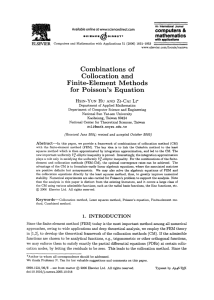
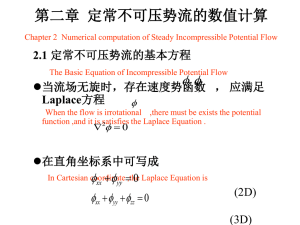
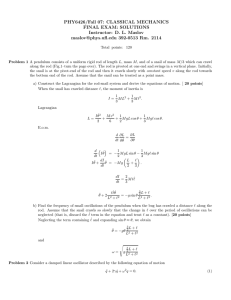

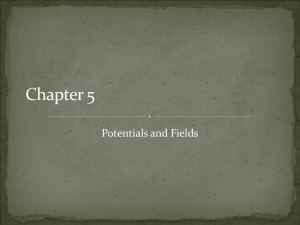
![Chem_Test_Outline[1]](http://s2.studylib.net/store/data/010130217_1-9c615a6ff3b14001407f2b5a7a2322ac-300x300.png)
